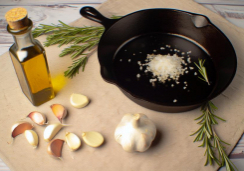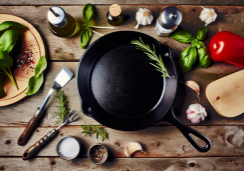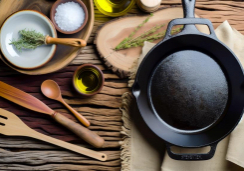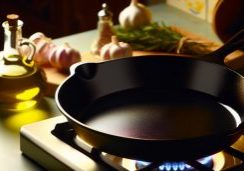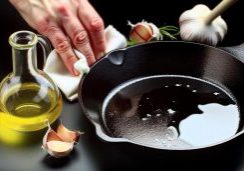Ultimate Cast Iron Skillet Seasoning Guide
When it's time to enhance the performance of your cast iron skillet, a proper seasoning is the gentle nudge it needs rather than a complete overhaul. As you stand in your kitchen, armed with a bottle of oil and a sturdy oven mitt, consider the transformative journey you're about to embark on. You'll learn the alchemy of turning a simple piece of cookware into a non-stick, rust-resistant culinary companion that could last a lifetime.
From choosing the right fats to the intricacies of heat application, you'll discover the secrets behind a perfectly seasoned skillet. But before you start this process, there's a critical piece of the puzzle you'll need to understand, a piece that will determine the longevity and efficacy of your seasoning. Stay tuned to uncover the key to unlocking your cast iron's full potential, ensuring every meal you cook is not only infused with flavor but also with a touch of tradition and craftsmanship.
Understanding Skillet Seasoning
To keep your cast iron skillet in prime condition, it's crucial to understand the role of seasoning. Seasoning cast iron involves creating a protective layer of carbonized oil, achieved through a method known as polymerization. This transformative process occurs when oil is heated to a high temperature on the skillet's surface, bonding to the metal and hardening into a durable coating.
When you season your cast iron, you're essentially building up thin layers of this polymerized oil, which forms a hard, blackened skin. This skin is the secret behind your cast iron cookware's improved heat retention and distribution, allowing you to cook with precision and ease. The seasoning on cast iron also shields your skillet from moisture that can lead to rust.
For a successful seasoning process, it's vital to select an oil for seasoning with a high smoke point, such as vegetable, canola, or flaxseed oil. Regular maintenance, like cooking with oil and a post-use oil rub, upholds the skillet's seasoning, ensuring a lasting, slick, and protective coating.
Preparing Your Cast Iron
Before you embark on the seasoning of your cast iron skillet, ensure it's clean and completely dry to set the stage for a smooth, non-stick surface. Whether you're looking to season a new cast iron skillet or maintain an existing one, starting with a pristine base is crucial.
Select an oil with a high smoke point, such as vegetable oil or flaxseed oil, to begin the process. Preheat your oven to a temperature that will allow the oil to polymerize correctly, generally around 350 to 500 degrees Fahrenheit, depending on the oil. Apply a thin layer of oil to the entire skillet, ensuring you rub the oil into every nook and cranny. This is vital for creating an even layers of seasoning.
Place the pan upside down in the oven to prevent pooling and bake it for at least an hour. This will help the oil to break down and bond with the iron, creating the non-stick surface you're after. After the skillet has cooled, repeat the process several times. This builds up the layers of seasoning, ensuring a durable and effective cooking surface.
Applying the Oil
Begin by using a paper towel to evenly distribute a thin layer of high-smoke-point oil across the surface of your cast iron cookware, avoiding excess to prevent a sticky finish. The right oil is key to successful seasoning—opt for vegetable oil, canola oil, flaxseed oil, or melted shortening, all known for their high smoke points. This is crucial because the oil needs to withstand high heat during the seasoning process without burning off too quickly.
To apply the oil, start at the center of the skillet and work your way to the edges, making sure the layer is evenly distributed across the entire surface, including the sides and the bottom. Be thorough, but conservative; you don't want to drench your cookware. Pooling or thick spots can result in an uneven seasoning, so after you've covered every nook and cranny, take a moment to wipe off any excess oil with a clean paper towel.
Baking the Seasoning
Once you've evenly applied the oil, preheat your oven to 400°F to set the stage for the seasoning magic to happen. This heat is crucial for the best oil to polymerize and form a good layer of seasoning. It's the transformative step where your diligent oiling becomes a durable, non-stick surface.
Step 3: Heat. Carefully place your pan upside down on the oven's middle rack. This position ensures that any excess oil drips away, leaving an even coat. Bake the pan for one hour, letting the oil baked into the surface create a protective layer. You'll know you're doing it right if the pan is still smooth to the touch after cooling.
After the hour is up, turn off the oven and let the cookware cool down completely inside. Patience is key here; don't rush to season your pan or check on it. Once cool, inspect your skillet – you're aiming for a shiny, black cooking surface that's ready for action.
Repeat this process a few times for an even stronger seasoning. Remember, the more you cook with it, the better it gets, so don't shy away from using your newly seasoned cast iron skillet!
What are the best tips for seasoning a cast iron skillet?
To season your cast iron skillet, start by washing and drying it thoroughly. Then, use a paper towel to spread a thin layer of oil all over the skillet. Place it upside down in a 350°F oven for an hour. Let it cool, and your skillet will be perfectly seasoned.
Maintaining Seasoned Cookware
Having established a solid base by baking in the seasoning, it's crucial to keep your cast iron skillet in top shape with regular maintenance. Each time you use your cast iron, you're given an opportunity to enhance the iron seasoning. Cook with oil, and you'll add layers to the seasoned cast iron, improving its non-stick properties incrementally.
After cooking, while the pan is still warm, clean a cast iron skillet using a stiff brush or scraper to remove leftover food particles. Avoid soap, as it can strip the seasoning on your cast iron. Instead, rinse with hot water, and then wipe it down to ensure it's clean and dry. Any lingering moisture can lead to rust, so storing your cookware in a dry place is essential.
To maintain the oiled pan surface, give your skillet a light coat of oil after cleaning. This habit not only preserves the seasoning but also prevents food from sticking during your next culinary venture.
Conclusion
Now you're equipped to keep your cast iron skillet in top-notch shape! Just remember, a consistent seasoning routine is key.
Use the right oils, heat it up properly, and handle with care. Your efforts will pay off with a non-stick surface that'll make cooking a breeze.
Stick to these tips, and your skillet won't just cook your meals—it'll become a treasured kitchen ally.
Happy cooking, and may your cast iron serve you well for years to come!

